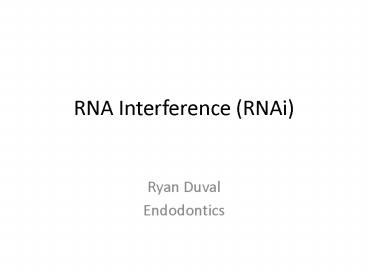RNA Interference RNAi - PowerPoint PPT Presentation
1 / 21
Title:
RNA Interference RNAi
Description:
Occurring at post-transcriptional level (plants and fungi) ... RISC becomes activated when the siRNA its carying is unzipped (utilizing ATP) ... – PowerPoint PPT presentation
Number of Views:699
Avg rating:3.0/5.0
Title: RNA Interference RNAi
1
RNA Interference (RNAi)
- Ryan Duval
- Endodontics
2
Discovery of RNAi
- First observed in petunias
- Napoli et al 1990
- Observed cosuppression
- Occurring at post-transcriptional level (plants
and fungi) - Fire et al 1998 silencing of genes in nematodes
(nice Prize 06) - Mammalian cells chemically synth or expressed
from plasmid or viral vector
3
Goals of RNA interference
- Defending cells against parasitic genes
- Defense from viruses
- Defense from transposons
- Directing development and gene expression in
general
4
RNAi
- Gene silencing mediated by double-stranded RNA
- Silencing of gene expression
- Results from cleavage and degreadation of a
target genes mRNA - Also results from blocking translocation of
intact mRNA - Usually about 20 25 base pairs long
RNA Interference Howard Hughes Medical Institiute
5
Workings of RNAi
- Dicer recognizes and cuts the double-stranded RNA
(dsRNA not common) - Results short 21 to 25 base-pair molecules
called small interfering RNAs (siRNAs) - siRNAs bind to several proteins (3 overhangs)
- Forming RISC (RNA-induced silencing complex)
DICER
6
RNAi contd.
- RISC becomes activated when the siRNA its carying
is unzipped (utilizing ATP) - Activated RISC bind to target mRNA
- RISC subunits then cleave mRNA
- Other proteins degrade mRNA prevent protein
production
7
RISC
- The two dsRNA pathways
- Exogenous
- Coming from infection by VIRUS w/RNA genome
- By lab manipulation
- Endogenous
- Pre-microRNA expressed from RNA-coding genes in
the genome - Both pathways converge at the RISC complex
8
RISC
- How the activated RISC complex locates
complementary mRNAs within the cell is UNKNOWN? - Located in P-bodies (cytoplasmic bodies)
- The active components of RISC are ARGONAUTE
proteins - Endonuclease
- Cleaves the the target mRNA strand complementary
to bound siRNA
9
Overview
- 20-25nt length (siRNA)
- siRNA separated into single strands
- Single strands integrated into RISC
- siRNA induce cleavage of the mRNA
- Preventing it from being used as a translation
template
10
Recognizing the dsRNA
- Detected and bound by effector protein
- RDE-4 in nematodes (C. elegans)
- R2D2 in Drosophila
- Both stimulate DICER
11
Gene knockdown
- A drastic decrease in the expression of a
targeted gene - Studying the effects of the decrease can show the
physiologic role of the gene product - RNAi may not totally abolish expression of the
gene knockdown vs knockout
12
RNAi applications
- Silencing CD44 (hyaluronan receptor) gene in
nasopharyngeal carcinoma ? malignant potential
of the cells. Jod et al 2007, Shi Oncol Rep
2007 - Expression of p27 (common protein in oral
squamous cell carcinoma), siRNA inhibited the
cell proliferation in vitro and in vivo of the
p27. Kudo et al Oral Oncol 2005 - siRNA used for the treatment of ankylosis and
periodontal disease. Yamada et al J Biol Chem
2001, 2007
13
Various RNAi uses
- Topical microbicide treatments of HSV II Jiang,
Milner Oncogene 2002 - Knockdown host receptors for HIV Crowe AIDS
Supp 2003 - Silencing Hep A and Hep B genes Kusov et al J
Virol 2006 - Silencing Influenza gene expression Jia, Zhang,
Liu Biotechnol Lett 2006 - Inhibition of LPS induced osteoclast formation
and cytokine stimulation Fahid et al JOE 2008
14
Application of Small Interfering RNA for
Inhibition of LPS-Induced Osteoclast Formation
and Cytokine Stimulation
- Purpose Suppression of NFATc1 (transcription
factor) expression in monocytes and osteoclast
cells using RNAi technique
15
Background
- Bone homeostasis
- RANKL (TNF family)
- Induces osteoclastogenesis
- LPS ?express RANKL osteoclast formation
- Final stage of osteoclast differ. NFATc1 is
crucial part of osteoclast differentiation. - Inhibit NFATc1 pathway ? inhibit bone
destruction?
16
Materials/Methods
- Mouse hematopoetic cells ? osteoclasts
- siRNA transfection (silencing NFATc1
- ELISA for TNF-a/IL-6
- Immunocytochemistry
- Staining of nuclei
17
Materials/Methods
- Primers for detection of
- Cathepsin K gene CSK
- IL-6
- TNF-a
- Compare osteoclasts transfected w/control vs
NFATc1 siRNA
18
Results
19
Conclusion
- Deliver siRNA into cytoplasm w/? efficiency
- Significant ? of TNF-a and IL-6 in response to
LPS stimulation - Significant ? in of mature osteoclasts in
response to LPS - ? in osteoclast-specific gene expression to LPS
stimulation
20
RNAi Challenges
- Systemic delivery obstacle (for RNAi drugs)
- How to control the amount of siRNA being
delivered (above or below therapeutic levels) - Possible stimulation of off target genes
- Long-term effects
21
Any Questions?































